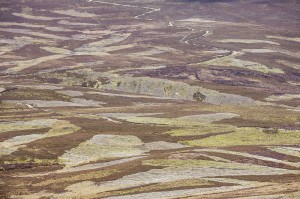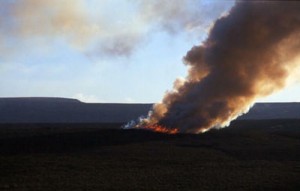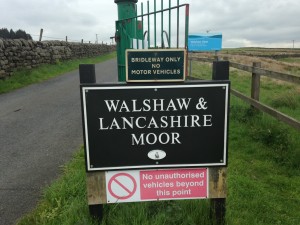
If you had a rainforest, and slashed and burned it, you’d be putting a lot of greenhouse gases into the atmosphere, just as surely as if your nation ran a lot of gas-guzzling cars. Natural ecosystems often act as carbon stores which sequester greenhouse gases – forests are the obvious ones but peatlands are also very important stores on a UK and an international scale.

Remember last year’s Leeds University study which showed that intensive management of our uplands for driven grouse shooting is a source of peatland degradation and increased carbon emissions (and pollution of water courses, reduction in aquatic biodiversity and probably of increased flood risk too)? It’s no wonder that upland management will come under closer and closer scrutiny since the evidence is pretty strong, and keeps growing as far as I can see, that grouse moor management is an anti-social practice, carried out for the benefit of the few at the expense of the many. Driven grouse moors are places where your protected wildlife is killed and your climate damaged too. We shouldn’t tolerate this Victorian land use now we have twenty-first century information.
 Remember Walshaw Moor? The RSPB has a complaint still being considered by the EU against the UK government (and Defra in particular) about the burning of blanket bogs by the British grouse industry. It would be a bit crazy, wouldn’t it, if a government delivery body (Natural England) was allowing management practices to continue which amount to mismanagement practices? It would be crazy, wouldn’t it, if a government delivery body allowed mismanagement of the uplands by grouse shooting interests which reduced the effectiveness of the government to meet its statutory obligations under the Climate Change Act?
Remember Walshaw Moor? The RSPB has a complaint still being considered by the EU against the UK government (and Defra in particular) about the burning of blanket bogs by the British grouse industry. It would be a bit crazy, wouldn’t it, if a government delivery body (Natural England) was allowing management practices to continue which amount to mismanagement practices? It would be crazy, wouldn’t it, if a government delivery body allowed mismanagement of the uplands by grouse shooting interests which reduced the effectiveness of the government to meet its statutory obligations under the Climate Change Act?
Why should an artificial, entirely contrived process such as muirburn be sold as a tool for management of an eco-system? It’s ludicrous. According to info I’ve read from the John Muir Trust the evidence is that natural fires in the uplands only occured once every two or three hundred years so they are not a regular feature of upland habitats. In 1997 a very good mate and I were trudging across Ilkley Moor when he suddenly turned to me and said ‘Aren’t moors crap? Actually hardly anything lives on them’. Was almost a heretical remark at the time, but George Monbiot has certainly broken through that wee taboo or at least tried to. There is nothing we have on grouse moors that wasn’t here already, and a good few of the limited number of species that could do well on them such as mountain hares and obviously, hen harriers, are heavily persecuted. Even naturally more open areas wouldn’t be heather monocultures, they’d have wetter bits, varied vegetation and clumps of trees and scrub (and oh my god isn’t scrub a swear word to the Moorland Association). Far, far better for a much wider range of wildlife including moorland species. All of this lost because some people put a higher financial value on using a wild bird as a feathered clay pigeon rather than appreciating nature. Notice how angling bodies have been incredibly anti beaver, an animal that was a component of ecosystems for about two million years and that common sense and evidence from abroad indicates is good for fish and rivers, but have said absolutely nothing about Leeds University’s EMBER report which shows how bad grouse moors are for aquatic life. The paid representatives of angling are not doing their job, if they were a lot of anglers would be signing up against grouse moors. Mark, can’t wait for your new epetition!
” the evidence is that natural fires in the uplands only occurred once every two or three hundred years”. That’s an interesting point. I wonder what the consequences of drastic climate change might be for the uplands. Might it be that they might dry out to the extent that we have some really massive fires?
Weird that burning on this scale is allowed while farmers forced to stop burning straw after combining years ago
That was because people wanted to increase herbicide, fungicide and molluscicide use
Indeed… I think some research into the reasons for the stubble burn ban is required. Muirburn is a highly damaging practice which needs to be stopped. We really need a good understanding of the reasons behind the stopping of lowland burning. Surely the same rules should apply?
Stubble burning was never particularly environmentally damaging, other than the very occasional hedgerow being singed, it certainly didn’t contribute greatly to CO2 emissions. It was banned in deference to misinformed public opinion and under the banner of public nuisance.
Personally I’d rather have put up with the ocassional bit of smoke for a few months of the year than the current alternative. I’m not terribly fond of metaldehyde laced drinking water, nor was I a fan of methiocarb, but never mind so as long as clothes on the washing line continue to smell of a synthetic alpine meadow then who cares? And don’t you just luurrve the smell of Chlorothalonil on an early spring morning?
Ernest – thank you. I was thinking of making a similar comment but you have done it so much better than I could. Stopping stubble burning was mostly about bits of smut falling out of the sky as I remember it.
Don’t you just love the way that reports to Parliament routinely state the Bleeding Obvious, while government and national authorities blithely ignore said advice and continue to destroy the natural environment?
As I said on Twitter earlier, here’s a different perspective https://t.co/sdnhljD1QY where Scotland is seen as the European stronghold for upland, heather-rich heath.
Doug – welcome back to this blog and thank you for your comment. But it is rather laughable, isn’t it? In response to a massive evidence-based report on the greatest environmental threat to our planet (which points the finger at poor management of about a quarter of the UK’s upland blanket bog), your response, as Chief Exec of Scottish Land and Estates is to refer us to an article that basically says ‘heather is pretty’. We know that. But thanks anyway.
The visual impact of muirburning on the Highlands now is nothing short of a national scandal, yet from amenity societies, national park authorities and SNH there is silence despite a large number of the hills east of the A9 having their aesthetic appeal reduced to that of a pit bing. Ben Vrackie, say, is comparatively unscathed and is still a fine sight. Compare and contrast with the piebald abortion that is Meall Chuaich. (OK, so Vrackie is a better looking hill anyway, but you get the idea).
Hi Doug, what are the goalposts here? I am not aware of moorland or peat bogs or diverse uplands having to be heather rich/dominated by heather in order to form peat protection and/or sustainable services, including hunting. There are really simple lessons we can take from looking at the management of Europe wide peat and moorland: 1. we don’t need managed burning, 2. multiple services (inc low scale hunting (not intensive shooting(there is a difference))) and access and income are compatable 3. moorland and peatland habitats within a mosaic of mixed open and woodland areas are far more diverse at all taxonomic levels (yes numbers of many species may decline but such metrics are a bit weird anyway)…. just sayin :0)
I was bought up in Hertfordshire right opposite a field which must have been 20 – 30 acres as a child I used to LOVE stubble burning – hours of pyrotechnic fun.